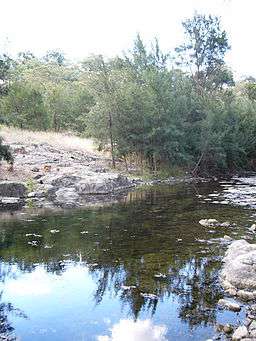Sofala, New South Wales
| Sofala New South Wales | |
|---|---|
|
Denison Street, the unusually narrow main street of Sofala | |
 Sofala | |
| Coordinates | 33°04′50″S 149°41′35″E / 33.08056°S 149.69306°ECoordinates: 33°04′50″S 149°41′35″E / 33.08056°S 149.69306°E |
| Population | 208 (2006 census)[1] |
| Location | |
| LGA(s) | Bathurst Regional Council |
| State electorate(s) | Bathurst |
| Federal Division(s) | Calare |
Sofala is a village in New South Wales, Australia, 255 kilometres (158 mi) north-west of Sydney, within Bathurst Regional Council. It is located beside the Turon River. Sofala is just off the Bathurst-Ilford Road, with only local traffic through the town itself. At the 2006 census, Sofala had a population of 208.[1]

Sofala came about as a direct result of the gold rush which had been spurred on when Edward Hargraves discovered gold at Summerhill Creek on 12 February 1851. By June of that year, thousands of people had set up mining operations in the valley, and both the Royal Hotel and a general store were built in 1851 to handle the increased demand. Initially, gold was found in the area known as Gold Point on the Turon River. When the alluvial gold ran out, mining turned to quartz reef mining.[2] The town was a centre of opposition of the gold licensing system in New South Wales at the time. A considerable proportion of the miners were Chinese.[3]
Sofala Public School was established in 1878.[4] There was an Anglican church and a Catholic convent.[5]
Attractions today include the gold-rush-era Sofala Royal Hotel[6] and the old gaol. Small-scale gold workings are still active in the town. Sofala has been reported to be the oldest surviving gold-rush town in Australia. There are still gold prospectors who pass the time using metal detectors, gold pans, and sluice boxes to recover small quantities of gold dust.
Russell Drysdale's painting Sofala, a depiction of the main street of the town, won the Wynne Prize for 1947.[7]
The 1974 Peter Weir film The Cars That Ate Paris was filmed in the town. Village scenes in the 1994 John Duigan film Sirens were also filmed in Sofala.
A noted business is Finglinna Studios, which supplies stained glass to churches and other public buildings.[8]
Access
- From Bathurst, Sofala is around 50 km north along the sealed Bathurst-Ilford Road; from Sydney, around 30 km from Ilford.
Attractions
- Prospecting
- Walk along the Turon River
- Cycle
- Historical walks and tours
- Riverside campsites
- Old Sofala Gaol museum/cafe/accommodation[9]
- Turon Technology Museum[10]
- Tanwarra Lodge luxury accommodation[11]
See also
Notes and references
- 1 2 Australian Bureau of Statistics (25 October 2007). "Sofala (State Suburb)". 2006 Census QuickStats. Retrieved 19 November 2009.
- ↑ Mudgee District History: Sofala; Sofala, Sydney Morning Herald, 10 Dec 2008.
- ↑ B. Hickson, Chinese in Sofala, Mudgee History.
- ↑ Sofala Public School.
- ↑ Mudgee District History: Churches in Sofala
- ↑ Sofala Royal Hotel
- ↑ "Sofala". Collection. Art Gallery of New South Wales. Retrieved 18 July 2015.
- ↑ Finglinna Studios
- ↑ Old Sofala Gaol
- ↑ Turon Technology Museum
- ↑ Tanwarra Lodge
External links
![]() Media related to Sofala, New South Wales at Wikimedia Commons
Media related to Sofala, New South Wales at Wikimedia Commons